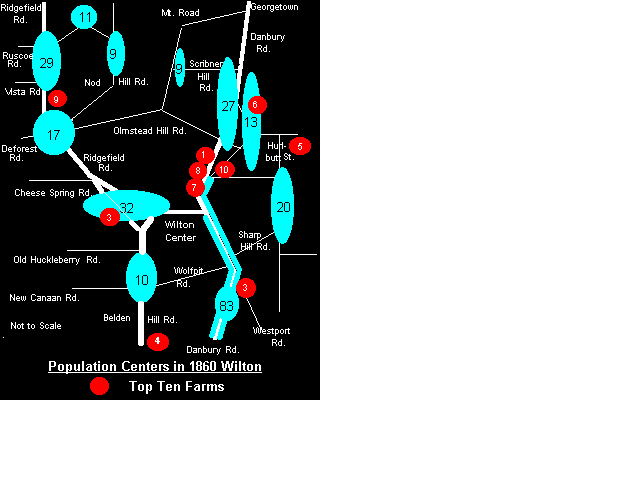The simplified map on the left uses today's street names and shows these clusters.
 Danbury Road from the Norwalk border up to just above the Center was quite densely populated with a total of 83 houses.
After a short open area, the next cluster starts just below Olmstead Hill Road and continues up to Scribner Hill Road with 27 more houses. Just to the east of this is another group of 13 houses along Cannon and Seeley Roads. The rest of Danbury Road was more lighly built up until it reached Georgetown and the town line. Over on Hurlbutt Street, some 20 houses were concentrated between Sharp Hill Road and Skunk Lane.
Danbury Road from the Norwalk border up to just above the Center was quite densely populated with a total of 83 houses.
After a short open area, the next cluster starts just below Olmstead Hill Road and continues up to Scribner Hill Road with 27 more houses. Just to the east of this is another group of 13 houses along Cannon and Seeley Roads. The rest of Danbury Road was more lighly built up until it reached Georgetown and the town line. Over on Hurlbutt Street, some 20 houses were concentrated between Sharp Hill Road and Skunk Lane.
The other major north/south corridor was Belden Hill Road leading into Ridgefield Road. On Belden Hill the concentration was between Wolfpit Road and Old Huckleberry Road (10 houses). In the triangle formed by Drum Hill, Ridgefield and Belden Hill Roads and the road down to today's Center, there was a total of 32 structures. There was then a group of 17 buildings centered around DeForest Road and further up another grouping of 29 between Vista Road and Ruscoe Road (North Wilton).
In between the two corridors, there was a group of nine along the west side of Nod Hill, a cluster of 11 at the northern bulge of Millstone Road and another nine where Scribner Hill Road meets Mountain Road.
Size of Farms

Farm Animals

"There were horses on 201 farms. Thus, 62 had no horses at all and there were 54 farms which had at least one horse but no oxen. The horse seems to have been the poor man's animal. 144 farms had only one horse. Of the 57 farms which had more, 44 had a pair, 8 had 3 horses, 4 had two pair and only one, Mrs. William Belden of Egypt, had 5 horses. It would appear that there were no important horse breeders in Wilton at this time."
"The largest herd of milch cows was owned by Abijah M. Jones of Drum Hill. With 25 cows he did not make any butter at all, nor did his neighbors Benijah Gilbert (12 cows) and Thomas Paddock (22 cows), both of Belden's Hill. Probably all three shipped whole milk to Norwalk. Mr. Jones' herd was the most valuable in town, $1350. Closely following were Samuel B. Sturges of Sturges Ridge, Mrs. Col. William Belden of Pimpawaug and Isiah Keeler of Bald Hill, each with herds worth $1200. Five others had herds of $1000."
"Swine were kept on almost every farm, all but 14 had at least one hog. The larger herds were those of Eliphalet Sturges of Sugar Street and William J. Jelliff of Belden's Hill with 15 each. Jelliff had a large general farm but Sturges seems to have specialized in swine as did James Davenport of Center who kept 14 hogs. William D. Gregory, of Belden's Hill, and Ira Betts II, of Pimpawaug, each had 11. There were 746 pigs in the whole town."
"Sheep were not so numerous, only 441 in 45 flocks. The eight larger breeders accounted for 180 of them, as follows:
| Sheep | Wool, lbs. | |
|---|---|---|
| Charles Morgan, Miller, Nod | 40 | 100 |
| Capt. Ira Betts I, Hatter | 28 | 40 |
| Hon. Charles Marvin, Pimpawaug | 27 | 60 |
| Alfred Raymond, Hurlbutt St. | 25 | 75 |
| Joel Godfrey, Honey Hill | 20 | 50 |
| John Hurlbutt, Hurlbutt St. | 20 | 60 |
| Charles Cannon, Pimpawaug | 20 | 30 |
Morgan was obviously the largest sheep owner but the Hurlbutt St. flocks of Raymond and Hurlbutt were superior wool producers. The total amount of wool sheared in the town was 1249 lbs. or 2.8 lbs. per animal."
"Cattle were slaughtered for meat on all but eight farms. The average was only about $80 per farm, total $21,234. The two butchers in town accounted for 265,000 lbs., worth $19,500 or 7.2 cents per pound. These were probably cattle from Western New York which had been brought to the feed lots in Wilton for corn fattening and sale to Norwalk or New York. If the butcher's price of 7.3 cents per pound applied to the census of animals slaughtered on the farm, this would mean an average of about 1000 lbs. of meat per farm per year, for five persons. On this basis, meat could not have been rare on the farm table. The only large farm slaughterers were Lewis Raymond of Hurlbutt St., $350, and Sylvestor Olmstead of Nod, $300. Neither had very large farms nor many cattle."
"The item "Other Cattle", of which there were 618, as against 742 cows, and which were found on almost every farm in the town, may refer to young stock and also include steers being fattened for the butchers, as this was June. There were some fairly large herds. Alfred Olmstead and his neighbor, John S. Olmstead of Nod, each had 20 head. So did Isaiah Keeler of Bald Hill, one of the largest farmers in town. Samuel B. Sturges of Sturges Ridge had 19. There were six others who had more than 10."
Farm Crops

"Farm crops were not very extensive. Nearly everyone raised corn,oats,, potatoes and hay. There were no very large producers. Mrs. Col. Belden of Pimpawaug and William Cable, a merchant of Kent, each produced 500 bu. of corn a year. As Cable had only 23 acres, this was an excellent yield. His only other crop was 50 bu. of oats for his one horse. On only eight other farms was the corn crop 300 bu. or more. Thus, of the 26,195 bu. raised per year, the average was about 100 bu., the staple for home use and for fattening animals.
The crop of oats was about the same, 25,775 bu. Five farmers grew 500 bu. each of this crop. Much less rye was grown, 5800 bu. and almost no wheat., 652 bu. The largest producer of rye was John S. Olmstead of Olmstead Hill. He made 150 bu. Only a few others made 100 bu. This, too, must have been a crop for home use.
Wheat was grown on only 27 farms, an average of 24 bu. per faarm. The largest producer was Capt. John Jones of Salt Pound who made 80 bu. Only four others made more than 40 bu,, several on Buckingham Ridge. The Hessian fly, which damages wheat, was probably a pest in Wilton at this time.
Potatoeswere grown by almost everyone. The total product was 11,278 bu. or about 50 bu. per farm. The larger growers were Charles B. Sturges of Egypt, 200 bu., Purdy Sherwood of Salt Pound, 150 bu., and Thomas Paddock of Belden's Hill, 150 bu.
There were 4461 bu. of buckwheat grown on about half the farms (125), an average of about 35 bu. The largest grower was Charles B. Sturges of Egypt who raised 200 bu. Jonathan Middlebrook II of Salt Pound made 150 bu. and Hawley Olmstead II of Olmstead Hill 130 bu. Five others made 100 or more.
Hay was made on every farm in Wilton, 4658 tons or an average of 18 tons per farm. Fourteen farms produced more than 50 tons; of these, 4 had 75 tons each. The latter included the dairymen, Isaiah Keeler of Bald Hill and Abijah M. JOnes of Drum Hill as well as Hawley Olmstead II and John S. Olmstead, both of Olmstead Hill.
Grass and clover seed was collected on 16 farms to the amount of 109 bu. William S. Cole of Pimpawaug was the largest grower with 15 bu. Four others had 10 bu. each, one of them being Mrs. Eliphalet T. Smith of Hurlbutt St.
Only one grower of market garden produce is listed. This is John Hower, a German who lived on the Westport Road and is also listed as a shoemaker. On his 30 acre farm he had a horse and two cows, raised potatoes and $200 worth of garden products, as well as some honey.
Dairy and Orchard Products
"The principal product of the farms was butter of which 31 tons was produced each year from 742 cows. The larger producers were Deacon Wakeman Hubbell of Pimpewaug who made 1200 lbs. and Samuel F. Lambert of Kent with 1150 lbs. Only 17 others made 500 lbs. or more a year.
The largest herd of milch cows was owned by Abijah M. Jones of Drum Hill. With 25 cows he did not make any butter at all, nor did his neighbors Benijah Gilbert (12 cows) and Thomas Paddock (22 cows), both of Belden's Hill. Probably all three shipped whole milk to Norwalk. Mr. Jones' herd was the most valuable in town, $1350. Closely following were Samuel B. Sturges of Sturges Ridge, Mrs. Col. William Belden of Pimpawaug and Isiah Keeler of Bald Hill, each with herds worth $1200. Five others had herds of $1000.
Nine farmers made cheese, mostly in small amounts. Mrs. William Mallory of Georgetown, who had only 6 cows, made nearly half the cheese in town, 400 lbs. out of 925. Probably she bought the milk of her neighbors for this purpose. Col. Samuel Scott and Isaiah Keeler, both of Bald Hill, made 100lbs. apiece and Charles Seymour, also of Bald Hill, 75 lbs. The other 5 cheese makers accounted for 250 lbs.
Orchardproducts were derived from almost every farm but in quite small amounts, the average being less than $20 a year. The only producer of any considerable amount was Samuel Gregory of Grumman Hill who had $300 per year from his orchard.
Although the production of fruit per farm was small, "wine" which was probably cider was not in short supply. It was made on 76 (one quarter) of the farms, mostly in lots of 5 to 10 gallons per year. The largest producer in town,, however, was Charles B. Sturges of Egypt who made 1200 gallons, out of the 2011 for the whole town. The only other producer of any considerable amount was Deacon Benejah Gilbert of Belden's Hill who made 100 gals.
Honey was made on 23 farms, an average of 34 lbs. each. The largest producer was Ezra M. Smith of Bald Hill who made 200 lbs. Next were Mrs. Aaron Olmstead of Nod Hill and Jehiel Grumman of Kent who each produced 100 lbs.

